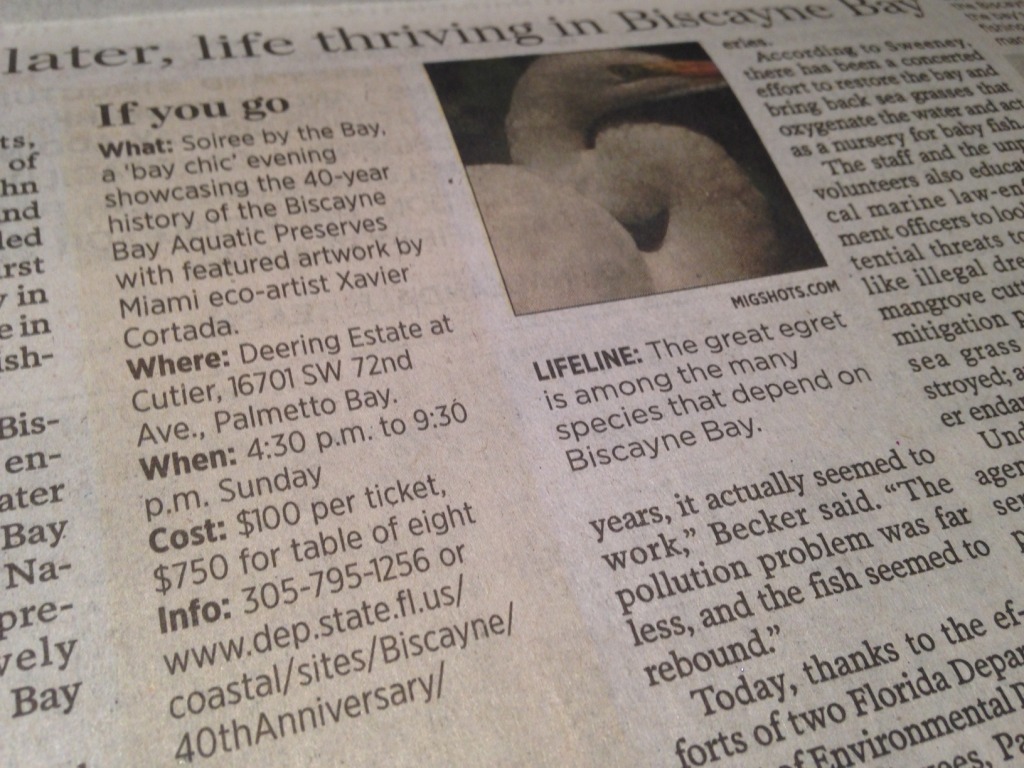Miami Herald
October 4, 2014

By Katie Lerpi
Forty years ago, the Florida Legislature created the Biscayne Bay Aquatic Preserve, a large swath of water in the bay for fishing, recreation and the protection of plants and animals.
Before the 1970s, Biscayne Bay was one of Miami-Dade’s most pressing environmental problems. Cities were polluting the water with raw sewage and anything else that could be dumped into it. And there was no concerted effort to manage dredging, runoff, and fishing.
In 1969, commercial fisherman Walter Kandrashoff had started stirring public outrage at the diseased, deformed fish being caught in the bay. Eventually studies showed fish in Biscayne Bay had abnormalities like missing and stunted fins, backward scales, indented spines and cancerous tumors.
“I was seeing over and over again one particular type of abnormality, this involved the dorsal spine,” said Joan Browder, a leading scientist with the National Oceanic and Atmospheric Administration on Virginia Key. “The fishery biologists here at the lab hadn’t seen anything like this.”
Kandrashoff’s efforts, combined with the work of two state legislators, John Cyril Malloy, R-Miami, and Alan Becker, D-Miami, led to the creation of the first preserve in Biscayne Bay in 1974. The second preserve in Biscayne Bay was established in 1975.
One part lies off Key Biscayne, and the second encompasses the underwater landscape in Biscayne Bay that is not in Biscayne National Park. The two preserves are collectively known as the Biscayne Bay Aquatic Preserve.
On Sunday, friends and supporters of the preserve will hold a soiree to celebrate its 40th anniversary and to raise awareness of the bay for future generations.
Biscayne Bay had been polluted for years, both before and after the preserves. Urban runoff, polluted with pesticides and assorted debris, washed into the rivers and streams that fed the bay, devastating the plants and marine life within it.
“I discussed it with John and I said, ‘Let’s do something about it,’” said Becker, now 68. In an effort to gain support for the bill, he and John took the Florida House of Representatives’ Environmental Protection Committee to Miami to see the bay firsthand.
The bill passed in one session.
“It was something John was very proud of, and so was I.”
The aquatic preserves, according to the designation in state law, were established “to be preserved in an essentially natural condition so that its biological and aesthetic values may endure for the enjoyment of future generations.”
“Over the succeeding years, it actually seemed to work,” Becker said. “The pollution problem was far less, and the fish seemed to rebound.”
Today, thanks to the efforts of two Florida Department of Environmental Protection employees, Pamela Sweeney and Laura Eldredge, and a group of committed volunteers, the bay has become a natural habitat for marine life, endangered species and the bottle-nosed dolphin.
“What it did was it turned around the bay,” said Sweeney, who is the manager of the Biscayne Bay Aquatic Preserves.
The preservation designation set rules for topics like drudging and filling, to retain some of the resources that the bay needed for fisheries.
According to Sweeney, there has been a concerted effort to restore the bay and bring back sea grasses that oxygenate the water and act as a nursery for baby fish.
The staff and the unpaid volunteers also educate local marine law-enforcement officers to look for potential threats to the bay, like illegal dredging and mangrove cutting; oversee mitigation projects where sea grass has been destroyed; and keep watch over endangered species.
Under Sweeney’s management, the aquatic preserves work with various partners such as the University of Miami to host community-wide events. The preserves also teach students about marine debris removal and habitat restoration.
But Sweeney said more needs to be done to protect the marine habitat and clean up the bay.
“I do still feel that people just really aren’t aware that we have this state aquatic preserve on their doorstep in the most urban part of Miami,” Sweeney said. “I feel like if people knew they might behave in a way that’s more protective, they might teach their children to protect the area to a greater degree.”
IF YOU GO
What: Soiree by the Bay, a ‘bay chic’ evening showcasing the 40-year history of the Biscayne Bay Aquatic Preserves with featured artwork by Miami’s eco-artist Xavier Cortada.
Where: Deering Estate at Cutler, 16701 SW 72nd Ave., Palmetto Bay.
When: 4:30 p.m. to 9:30 p.m. Sunday
Cost: $100 per ticket, $750 for table of eight
Info: 305-795-1256 or
www.dep.state.fl.us/coastal/sites/Biscayne/40thAnniversary/
Read more here: http://www.miamiherald.com/news/local/community/miami-dade/article2516002.html#storylink=cpy